—By Barbara A. Branca and Paul C. Focazio, New York Sea Grant
Oswego, NY, December 10, 2014 - In a few short weeks since their release in mid-September, New York Sea Grant’s informative “Dogs and Harmful Algal Blooms (HABs)” brochure (pdf) and fact sheet (pdf) were well-received via both traditional and social media platforms.
They’ve become our coastal program’s most widely-shared single piece of content on Facebook, Twitter and in the media since some of Fall 2012’s post-Superstorm Sandy quick response research and extension efforts. Why such the strong response? “It all goes back to our culture,” says author Dave MacNeill, a NYSG extension educator from the State University of New York (SUNY) at Oswego. “Americans are devoted pet owners.”
According to recent figures from the American Society for the Prevention of Cruelty to Animals, 37-47% of all households in the U.S. have a dog, translating to an estimated 70-80 million dogs owned. “We love our canine companions like they’re part of the family and knowing that their health and welfare could be at risk is what’s inspiring people to act.”
MacNeill knew there was an opportunity for Sea Grant to educate on the topic when he began noticing more and more reports of dogs becoming ill from the toxins produced by HABs in the Lake Ontario area. "People might get sick, but people's dogs are actually dying," said MacNeill.
HABs, especially in the state's fresh water, are overgrowths of cyanobacteria (blue-green algae) that cause water quality problems in lakes and ponds, including the occasional production of potent toxins. Of the 8,000 or so species of cyanobacteria, only about 40 produce toxins. However, these toxins can poison people, household pets, waterfowl and livestock. Because HABs are increasing in many areas, the number of dog poisonings from cyanobacterial toxins is also on the rise.
To keep dogs safe around local waterways, these publications – produced with financial support from the National Oceanic and Atmospheric Administration (NOAA) Center for Sponsored Coastal Ocean Research – provide pet owners with a safety checklist of symptoms of HABs poisoning and steps that can be taken if a dog is exposed to HABs.
"This brochure is a great addition to New York Sea Grant's outreach activities informing the public and management community of the rise and threats of freshwater CyanoHABs," said John Wickham, program manager with NOAA National Ocean Service, and one of MacNeill’s collaborators on the brochure. Others enlisted to assure scientific accuracy included Dr. Karyn Bischoff, a toxicologist at Cornell University Veterinary College, Scott Kishbaugh of NYS Department of Environmental Conservation, Dr. Lesley V. D’Anglada of the U.S. Environmental Protection Agency, Dr. Greg Boyer of SUNY College of Environmental Science and Forestry, Dr. Chris Gobler of Stony Brook University’s School of Marine and Atmospheric Sciences, and colleagues in the Sea Grant network.
“Cyanobacterial poisonings are under-reported in domestic animals because people haven’t been aware of the problem,” says Bischoff. “That could be changing since HABs have become more prominent in the news, as exemplified by, the recent microcystin bloom in Lake Erie that affected the water supply of Toledo, Ohio.”
NYSG has more information on harmful algal blooms at www.nyseagrant.org/habs. For interested groups, multiple hard copies of the publications may be made available. Please contact Dave MacNeill at dbm4@cornell.edu or (315) 312-3042.
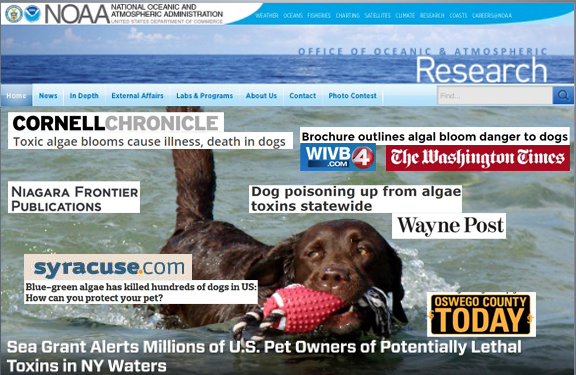
After news of the publications was announced by the Associated Press in September, dozens of U.S. media outlets – daily papers, university e-newsletters including the Cornell Chronicle, blogs and even waterfowl hunting magazines such as Ducks Unlimited
– followed suit, which extended the total potential reach to some 4
million people. One Facebook post shared by some 45 NYSG followers and
partners has been seen by over 2,000 users. And just a couple of tweets
made their way into the newsfeeds of some 350,000+ Twitter accounts
thanks to dozens of re-posts, including ones from NOAA (NYSG’s parent
federal organization), as well as NOAA Research, NOAA Coastal Oceans,
the U.S. Environmental Protection Agency's Region 2, Cornell Cooperative
Extension (and some of its individual County Offices), the National Sea
Grant College Program and a handful of its individual Sea Grant
programs in the U.S.
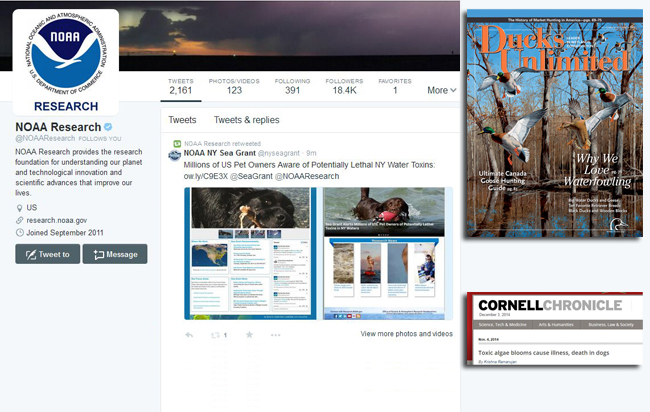
NOAA Research's re-tweet of NYSG's press release to announce the release of the "HABs and Dogs" brochure and fact sheet reached the Twitter feeds over some 18,400 subscribers alone. The November/December issue of Ducks Unlimited magazine (pdf)
featured Sea Grant's education materials in an article entitled “Dogs
and Harmful Algal Blooms.” The magazines has a circulation of 525,000. And, in addition to connecting in with the research community, Cornell University's in-house weekly newspaper the Cornell Chronicle has the potential to extended this information to its nearly 21,600 undergraduate, graduate and professional students.

Dogs like Walter (pictured above, at left) love to frolic in water, but may be at health risk from algal toxins. Sadly, the number of dog poisonings from these toxins is on the rise. Photo by Maxine Appleby. Axel (pictured a right), a 16 month old black lab was swimming in a river, downstream from a
reservoir experiencing a HAB event. Axel later collapsed and was taken
to a veterinarian. Despite treatment, Axel died five hours later. Photo courtesy of his owner, Jerry Benedick via KVAL.com.
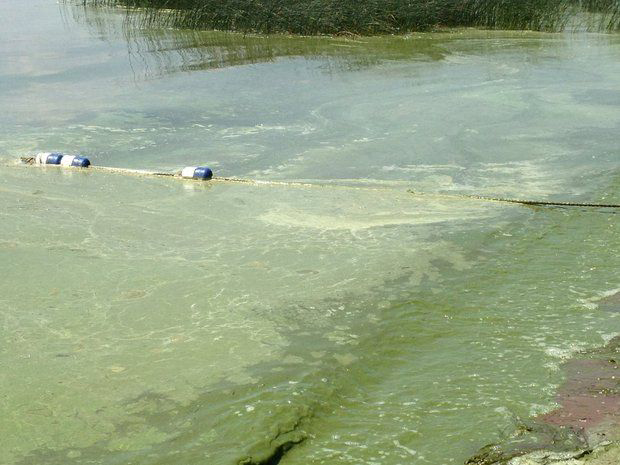
The beach at David C. Webb Memorial Park Bathing Beach on Oneida Lake (pictured above) was closed this past summer due to blue-green algae, which can sicken people and kill dogs. After publishing a mid-September story on Sea Grant's brochure that featured this image, The Syracuse Post-Standard received a handful of follow-up questions from its readers, one of whom wrote: "Is this just found in lakes or can this be in a large backyard pond also? I have algae in mine currently and have dogs too?" The reporter checked with NYSG's Dave Mac Neill, who responded: "Yes, they can be found in ponds and puddles. In ponds and puddles, the greatest risk to pets is if you can actually see visible green scums or stains in/on the water."
Another reader said: "So, since 1944 (68 years ago) 215 dogs have been documented as dying from blue-green algae toxicity. That is fewer than 3.2 dogs per year, hardly cause for panic."Sea Grant's response: "Keep in mind it says to rinse the rinse the animals coat with fresh water after being in the lake. If you go to a Lake Ontario beach - there will be algae more days than not - a person has to wade through it to clean water and waves. If the dog goes in with you, just walk him/her to a water fountain that has a low spigot and rinse him off - no problems. If the animal does not have good mobility - keep it out of the water or drive it to nearest public water and rinse them there ASAP - but rinse the dog of the algae. If it doesn't kill em, it can make them sick and, at the least they will come home with skin irritation."
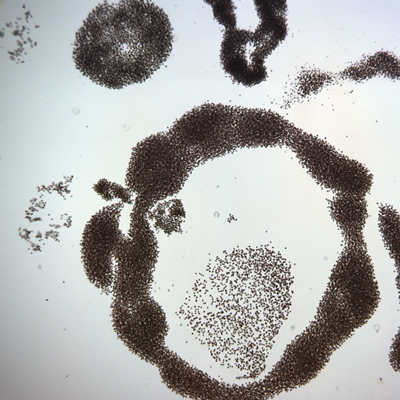
In New York, many toxic blooms are caused by Microcystis aeruginosa,
according to Dr. Greg Boyer, a leading researcher in toxic blooms. Here
the cyanobacteria are shown in colonies. Photomicrograph credit: Dr.
Greg Boyer
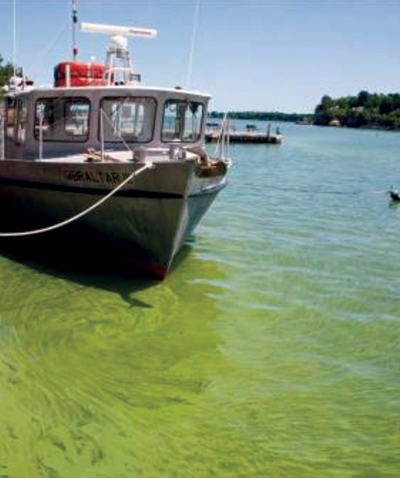
A cyanobacterial bloom in Lake Erie (
pictured at right). It’s
impossible to tell visually, by taste or odor whether such a bloom is
toxic (a HAB). Water samples must be analyzed for the presence of
toxins.
Photo by Ohio Sea Grant.
More Info:
New York Sea Grant (NYSG), a cooperative program of Cornell University
and the State University of New York, is one of 33 university-based
programs under the National Sea Grant College Program (NSGCP) of the
National Oceanic and Atmospheric Administration (NOAA). The NSGCP
engages this network of the nation’s top universities in conducting
scientific research, education, training and extension projects designed
to foster science-based decisions about the use and conservation of our
aquatic resources. Through its statewide network of integrated
services, NYSG has been promoting coastal vitality, environmental
sustainability, and citizen awareness about the State’s marine and Great
Lakes resources since 1971.
For updates on Sea Grant activities:
www.nyseagrant.org has RSS,
Facebook,
Twitter, and
YouTube links. NYSG also offers a free e-list sign up via
www.nyseagrant.org/coastlines for
NY Coastlines, its flagship publication, which merged with our e-newsletter,
Currents, in 2014 - is published several times a year.